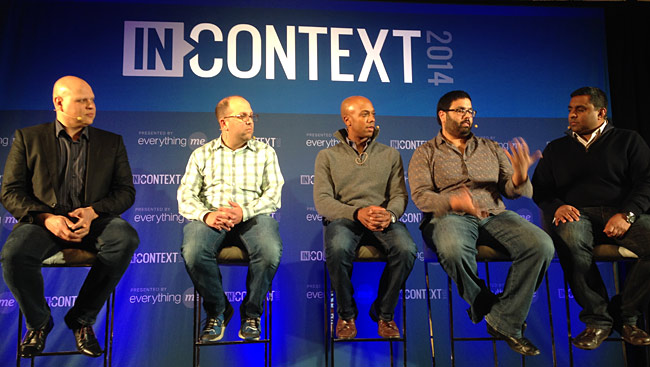The post InContext: The coming onrush of contextual devices appeared first on Inside Social Media.
]]>
VCs Josh Elman, Charles Hudson and Bubba Murarka (the three gents at center) were among the speakers on hand at InContext 2014 (Photo by JD Lasica).
Will contextual data create better user experience that drive more engagement?
Target audience: Tech professionals, SEO specialists, PR pros, brand managers, businesses, nonprofits, educators, Web publishers, journalists.
 We all know that the rush toward the mobile Internet is the mother of all megatrends. Less well known is a fascinating, still nascent subset of mobile: contextual mobile devices. That was the topic of an afternoon gathering yesterday called InContext 2014, hosted by EverythingMe yesterday at Terra Gallery in San Francisco’s SoMa district.
We all know that the rush toward the mobile Internet is the mother of all megatrends. Less well known is a fascinating, still nascent subset of mobile: contextual mobile devices. That was the topic of an afternoon gathering yesterday called InContext 2014, hosted by EverythingMe yesterday at Terra Gallery in San Francisco’s SoMa district.
(It’s a crazy week for me. Here are the Flickr photos I shot Monday and Tuesday at Startup Grind in Silicon Valley. Yesterday, InContext. Today, attending CMX Summit to hear about community building.)
At InContext, venture capitalists, entrepreneurs, mobile analysts and journalists exchanged views on what looks to be the Next Big Thing in mobile: contextual awareness. The idea, in short, is this: You give people what they want when they want it without them asking for it.
Contextual technologies are about anticipation, automation and personalization, as Dave Smiddy quoted Robert Scoble, author of “The Age of Context,” who was on hand to moderate one panel.

Seth Sternberg of Google pointed out that two to three years ago, you never had the need to log into Google. Today, you do, given the company’s push toward personalization and contextualization. You might type “My Flights” into a Google search query (see inset), or Google might ask if you want to download the Android version of the OpenTable app for your smartphone. The goal, he said, is “to create a better user experience that drives more engagement.”
Josh Elman of Greylock Partners: “We’re just on the cusp of figuring out what to do with all this data. What are the human problems we can really start to solve again?”
Andy Hicklrof ARO said the current period reminded him of the semantic text wars of the early 2000s. “We’re in same world with contextual technologies where we’re trying to extract meaningful data about how to provide value to people.”
Mobile analyst Benedict Evans offered some interesting questions: “What should your phone know? When can you stop reading 50 blogs to find something great? What can be done once the cloud can collect and analyze how 2 billion people use their phones?”
He also predicted Apple will eventually go to 800 million or 900 million smartphone devices and Android will go to 3.5 billion smart devices. “The potential poison for Apple comes down to innovation,” Evans said, “if Google offers an open platform and experience where more innovative things happen.”
His provocative, insightful Slideshare presentation is here:
Other highlights and takeaways
If there was one common note throughout the day, the speakers agreed that context still has a long, long way to go. Said Brendan Eich of Mozilla: “With my calendar, there’s ideal and there’s real. My phone still doesn’t know when I’m running late.”
• The cheerleading about Google Glass appears to be subsiding. (I predicted several months ago that version 1.0 will be a dud.) Scoble, who was rapturous about the possibiities of Glass in his Age of Context book published last fall, has recently soured on the technology’s prospects in the consumer market in the short term. Said Scoble: “We’re in the Apple II days, where the young kids are playing with it, but it’ll really become adopted by the public and in everyday use by 2020.”
• Andy Hickl on geolocation: “We’ve come to grips with the fact that we’re a blue dot on a map and someone in Mountain View knows where we are.”
• More Hickl: Over the next 18 months, contextual data will mature and “get into the hands of people who know how to do something useful with it – large companies with biz dev departments.” We’ll see if the corporate boys really know how to use it in the interests of consumers.
• Twice in the past week — yesterday with a TechCrunch reporter, last week with a VentureBeat reporter — the journalists couldn’t bother to give me 30 seconds of their time after they moderated panels on subjects I have some affinity with. As a former reporter, I can honestly say I’ve never done that, even when on deadline. Here’s a good rule to follow, people: Don’t disrespect your audience. It reflects poorly on your employer, and you might be losing a story lead (in yesterday’s case, you did).
Related
• Book review: ‘Age of Context’ captures the pulse of new tech
The post InContext: The coming onrush of contextual devices appeared first on Inside Social Media.
]]>